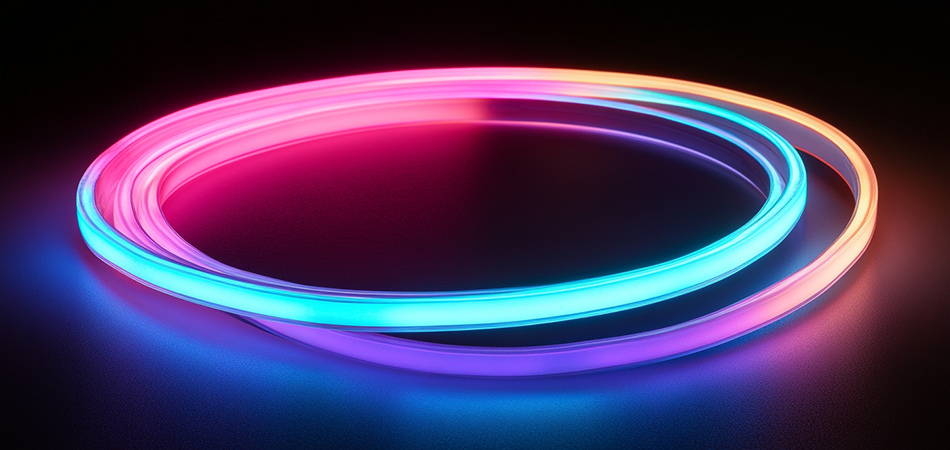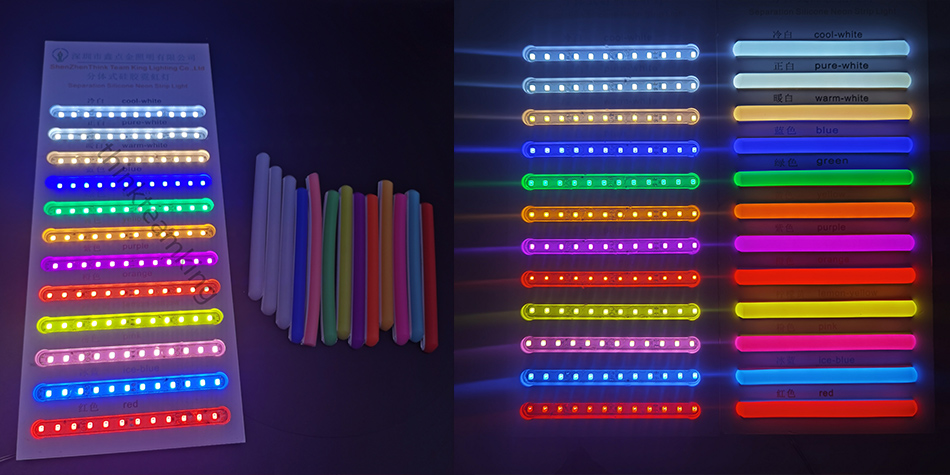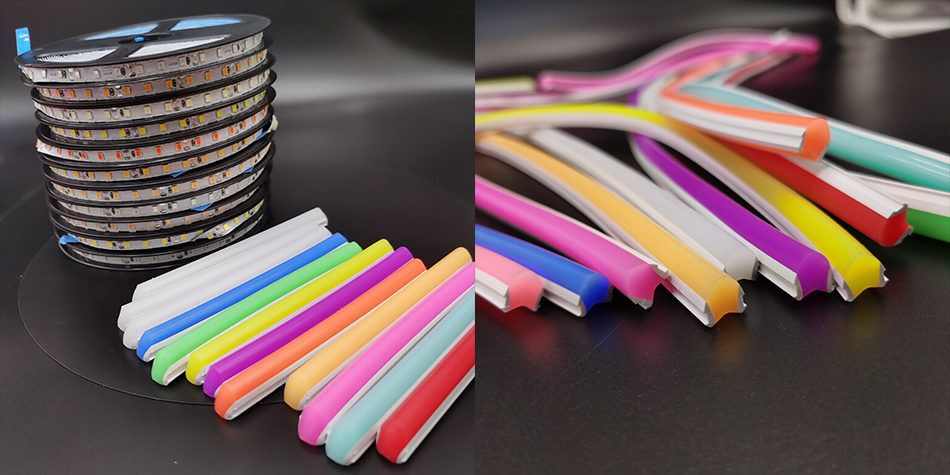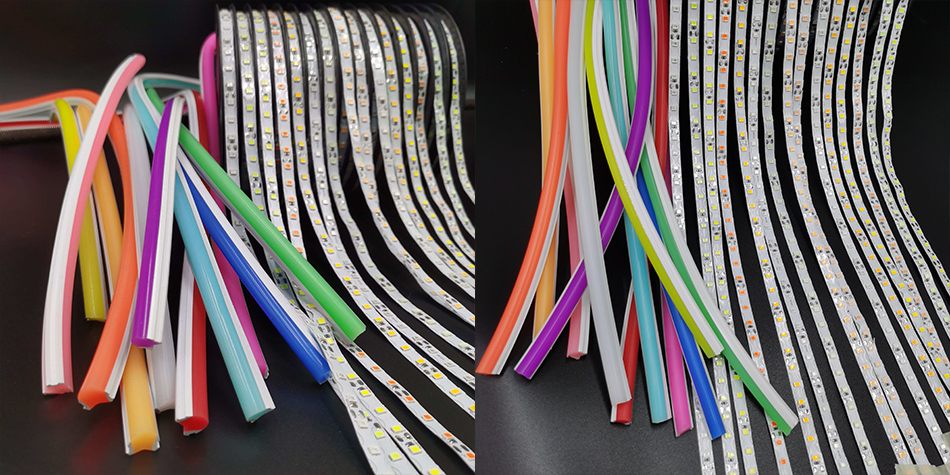Time:2025-08-13
RGB Silicone Neon Light Strip represents a breakthrough in dynamic lighting, combining the vivid color capabilities of RGB technology with the robust durability of silicone casings. These strips have redefined how users interact with light, offering millions of color options in a flexible, weather-resistant form that adapts to both indoor and outdoor environments. Unlike traditional single-color neon or basic LED strips, RGB silicone neon strips empower users to customize hues, patterns, and transitions, making them ideal for spaces where ambiance and versatility are paramount. As demand for personalized lighting grows in homes, businesses, and public spaces, these strips have emerged as a versatile solution that balances creative expression with practical performance. This article explores their color technology, material advantages, control systems, application versatility, and maintenance requirements, highlighting their role in transforming static spaces into dynamic environments.

The core of RGB Silicone Neon Light Strip lies in its advanced color-mixing technology, which enables a spectrum of hues and effects. Tri-color LED configuration is the foundation, with each strip containing red, green, and blue (RGB) light-emitting diodes packed closely together. When these primary colors are illuminated at varying intensities, they blend to create millions of secondary and tertiary colors—from soft pastels to bold, saturated tones. This mixing occurs at the diode level, ensuring uniform color distribution across the strip, even when bent or shaped into complex forms.
Color control precision is achieved through microcontrollers that regulate the brightness of each LED color channel. These controllers interpret user inputs—whether from a remote, app, or sensor—to adjust the ratio of red, green, and blue light, producing the desired hue. High-quality strips feature 16-bit or higher dimming for each channel, allowing for smooth transitions between colors rather than jarring jumps, which is critical for creating subtle effects like sunrise simulations or color fades.
Dynamic effect programming expands creative possibilities beyond static colors. Most RGB silicone neon strips include pre-programmed modes such as:
Fading: Gradual transitions between two or more colors, ideal for setting a calm, evolving ambiance.
Strobing: Rapid color changes at adjustable speeds, suitable for energetic spaces like dance floors or event venues.
Synchronization: Color shifts timed to music or sound, where built-in microphones detect audio frequencies and adjust light patterns accordingly.
Chasing: Sequential color movement along the strip, creating the illusion of light "flowing" from one end to the other, perfect for outlining architectural features.
White light capability is a key feature in advanced models, which combine RGB LEDs with a dedicated white diode (RGBW) or use color mixing to produce warm, cool, or neutral white tones. This eliminates the need for separate white lighting, allowing the strip to serve both color and functional illumination needs—for example, switching from vibrant party colors to soft white for dinner gatherings.

The silicone casing of RGB Silicone Neon Light Strip is engineered to enhance both durability and performance, making it suitable for diverse environments. Weather resistance is a standout benefit, with high-grade silicone providing protection against water, dust, and UV radiation. This allows the strips to be used outdoors—on patios, building exteriors, or garden features—without degradation from rain, snow, or sunlight. Unlike PVC casings, which can crack in extreme temperatures, silicone remains flexible in cold conditions and resistant to melting in heat, ensuring consistent performance year-round.
Impact and tear resistance ensures longevity in high-traffic or rugged settings. The silicone casing acts as a shock absorber, protecting internal LEDs and circuitry from bumps, drops, or bending. This makes the strips suitable for commercial spaces like retail stores, where they may be exposed to frequent handling, or industrial environments where durability is critical. The material’s elasticity also allows the strips to be bent around tight corners or wrapped around objects without tearing, expanding installation possibilities.
Light diffusion is enhanced by the silicone’s translucent properties, which soften the light from individual LEDs to create a smooth, uniform glow. This eliminates the "pixelation" common in bare RGB strips, where individual red, green, or blue diodes are visible, particularly from a distance. The diffused light maintains color accuracy while reducing glare, making the strips suitable for spaces like bedrooms or offices where harsh light is undesirable.
Chemical resistance ensures the strips withstand exposure to common substances like cleaning agents, oils, or outdoor pollutants. This is particularly useful in kitchens, where they may come into contact with food splatters, or garages and workshops where chemicals are present. The silicone casing can be easily wiped clean without damaging the surface or affecting light transmission.

RGB Silicone Neon Light Strip relies on intuitive control systems that put color customization at users’ fingertips. Wired controllers are a common entry-level option, featuring physical buttons or dials to select colors, adjust brightness, and activate effects. These are simple to install—typically plugging directly between the strip and power supply—and ideal for users who prefer tactile controls. Some wired controllers include small displays to show current settings, making it easy to recall favorite color combinations.
Wireless control offers greater flexibility, with options including infrared (IR) remotes, radio frequency (RF) remotes, and Bluetooth or Wi-Fi-enabled modules. IR remotes are budget-friendly but require line-of-sight to the controller, while RF remotes work through walls and over longer distances, suitable for large spaces like warehouses or outdoor patios. Bluetooth controllers connect to smartphones, allowing users to select colors via apps with color wheels or preset palettes, while Wi-Fi models integrate with home automation systems (like Alexa or Google Home) for voice control and scheduling.
DMX integration caters to professional installations, such as stage lighting or large-scale commercial projects. DMX controllers allow synchronization of multiple RGB silicone neon strips with other lighting fixtures, creating coordinated effects across a venue. This is essential for concerts, theaters, or architectural lighting where precise timing and uniformity are required. Advanced DMX systems support pixel-level control, enabling individual LEDs within the strip to display different colors, opening up complex patterns like text scrolling or video playback.
Sensor-based automation adds smart functionality, with some strips incorporating motion sensors, light sensors, or temperature sensors. Motion-activated RGB strips can change color when someone enters a room, enhancing security or creating interactive experiences. Light sensors adjust brightness based on ambient daylight, conserving energy while maintaining visibility. These automated features reduce manual input, making the strips more convenient for busy households or commercial spaces.

RGB Silicone Neon Light Strip’s combination of color flexibility and durability makes it suitable for a wide range of applications, transforming spaces with dynamic light. Residential interiors benefit from their ability to adapt to changing moods and activities. In living rooms, they can be installed behind TVs for bias lighting that reduces eye strain, with color options matching on-screen content for immersive viewing. Bedrooms use them as customizable nightlights, with soft fades between calming colors like blue and purple to promote relaxation. Home theaters leverage their synchronization capabilities, with strips pulsing to movie soundtracks for a cinematic experience.
Commercial spaces use RGB silicone neon strips to attract customers and reinforce brand identity. Retail stores install them in window displays to create eye-catching color changes that draw passersby, or along shelving to highlight products with brand-specific hues. Restaurants and bars adjust colors to match themes—warm oranges and reds for cozy winter evenings, cool blues and greens for summer vibes—or sync with music in nightlife venues. Hotels integrate them into lobbies, guest rooms, or outdoor pools, offering guests control over ambiance via in-room systems.
Outdoor environments showcase the strips’ weather resistance, with applications ranging from residential patios to public parks. Homeowners use them to outline deck railings, illuminate garden pathways, or highlight landscaping features, with color changes marking seasons or holidays. Municipalities install them in public squares, bridges, or building exteriors for festive lighting during events or to create iconic nighttime landmarks. Event planners rely on them for temporary setups like wedding backdrops, festival stages, or pop-up markets, where their portability and durability simplify installation.
Artistic and interactive installations leverage the strips’ dynamic capabilities to engage audiences. Artists incorporate them into sculptures or mixed-media works, using color changes to respond to viewer movement or sound. Museums and galleries use them to enhance exhibits, with lighting shifting to match displayed artworks or interpretive themes. Interactive public art installations allow visitors to control colors via touchscreens or mobile apps, turning passive observation into active participation.

RGB Silicone Neon Light Strip offers distinct benefits compared to other RGB lighting options, making it a superior choice for many applications. Durability sets it apart from bare RGB LED strips, which lack protective casings and are prone to damage from moisture, dust, or impact. The silicone casing ensures longevity in harsh environments, from humid bathrooms to rainy outdoor spaces, reducing replacement costs over time.
Flexibility and form factor surpass rigid RGB fixtures, which are limited to straight lines or fixed shapes. RGB silicone neon strips can be bent, twisted, or wrapped around objects, conforming to curved surfaces like columns, furniture edges, or signage. This adaptability eliminates the need for multiple fixtures to cover irregular spaces, simplifying installation and creating a more cohesive look.
Color consistency is enhanced by the silicone casing’s diffusing properties, which blend light from individual RGB diodes to create uniform color across the strip. Unlike uncovered RGB strips, which may show distinct red, green, or blue dots from a distance, silicone-diffused strips produce smooth, even color that maintains its integrity even when viewed from angles.
Energy efficiency combines with dynamic features, as the strips use low-power LEDs and allow for dimming of individual color channels. This reduces energy consumption compared to traditional RGB neon tubes, which are less efficient and offer fewer control options. Smart control systems further optimize efficiency by allowing scheduling or motion activation, ensuring the strips only use power when needed.
Proper installation is critical to maximizing the functionality and lifespan of RGB Silicone Neon Light Strip. Surface preparation involves cleaning the mounting area with isopropyl alcohol to remove dust, oils, or debris, ensuring the strip’s adhesive backing bonds securely. For rough or uneven surfaces—such as brick, stone, or textured walls—mounting clips or brackets provide additional stability, preventing the strip from lifting over time. Outdoor installations should include sealing cut ends with waterproof caps and covering connectors with silicone sealant to prevent water intrusion.
Power supply matching is essential, as RGB strips require more power than single-color strips due to their multiple LEDs. Using a power supply with sufficient wattage (matched to the strip’s length and LED density) prevents voltage drop, which can cause color inconsistency or dimming at the far end of long strips. For installations exceeding recommended lengths, power injectors can be added midway to maintain uniform power distribution.
Controller pairing varies by system but typically involves simple steps: plugging the controller into the strip and power supply, then syncing it with the remote or app. Wireless controllers may require Bluetooth or Wi-Fi pairing, while DMX systems need addressing to communicate with central controllers. Testing all color channels and effects after setup ensures the system is functioning correctly—checking that red, green, and blue each illuminate properly and that transitions are smooth.
Cable management keeps installations tidy, especially in visible areas. Concealing power cords and controller wires behind trim, in cable channels, or under carpets prevents clutter and reduces tripping hazards. Outdoor installations should use weatherproof cable connectors and route wires away from standing water to avoid damage.
Maintaining RGB Silicone Neon Light Strip is straightforward, with simple practices to ensure consistent color and functionality. Regular cleaning removes dust, dirt, or grime that can dull light output or block color transmission. A soft, damp cloth (avoiding harsh chemicals) is sufficient to wipe down the silicone casing, with outdoor strips benefiting from occasional rinsing with a hose (on low pressure) to remove pollen or debris.
Connection checks prevent intermittent color issues, as loose plugs or corroded terminals can cause one or more color channels to fail. Periodically inspecting and tightening connectors—especially in outdoor or high-moisture environments—ensures reliable performance. For wired controllers, checking for damaged cables or bent pins can resolve unresponsive buttons or uneven color.
Controller updates are important for smart systems, as firmware updates often improve color accuracy, add new effects, or fix connectivity issues. Most manufacturers offer app-based updates that are easy to install, ensuring the strip’s software stays current with new features.
Troubleshooting common issues includes:
Color imbalance: If one color appears dim or missing, checking for loose connections or damaged LEDs. Replacing a small section of the strip (at the nearest cut line) can resolve issues with faulty diodes.
Unresponsive controls: Resetting the controller or re-pairing it with the remote/app often fixes connectivity problems. For Wi-Fi models, checking router settings or moving the controller closer to the router can improve signal.
Flickering or strobing: This may indicate a power supply issue, such as insufficient wattage or voltage fluctuations. Upgrading the power supply or adding a voltage regulator can resolve this.
The evolution of RGB Silicone Neon Light Strip continues, with emerging technologies enhancing their capabilities and usability. AI integration is on the horizon, with strips that learn user preferences over time—automatically adjusting colors based on activity, time of day, or even mood detected via smart home sensors. For example, a strip might shift to energizing blues during morning routines and calming reds in the evening.
Advanced synchronization will enable more precise integration with media, including video content and 3D audio. Future strips may include pixel-level control with thousands of individual LEDs, allowing them to display moving images or text, transforming walls or surfaces into dynamic screens.
Eco-friendly materials will become more prevalent, with manufacturers using recycled silicone and energy-efficient LEDs to reduce environmental impact. Solar-powered RGB silicone neon strips are also in development, offering off-grid color customization for outdoor spaces like gardens or campsites.
Haptic control could add a new dimension, allowing users to adjust colors or effects by touching the strip itself—pressing or swiping to change hues, similar to smartphone interfaces. This would simplify control in spaces where remotes or apps are impractical.
RGB Silicone Neon Light Strip has transformed how we think about dynamic lighting, offering a perfect blend of color versatility, durability, and ease of use. Its ability to produce millions of hues in a flexible, weather-resistant form has made it indispensable in homes, businesses, and public spaces, where lighting is no longer just functional but a tool for expression. Whether creating a cozy ambiance in a bedroom, attracting customers to a store, or engaging audiences in public art, these strips prove that light can adapt, evolve, and respond to our needs.
As technology advances, their capabilities will only grow—becoming smarter, more sustainable, and more integrated into our daily lives. For anyone seeking to infuse spaces with personality, energy, or mood, RGB Silicone Neon Light Strip is more than a lighting solution—it’s a canvas for creativity, limited only by imagination.